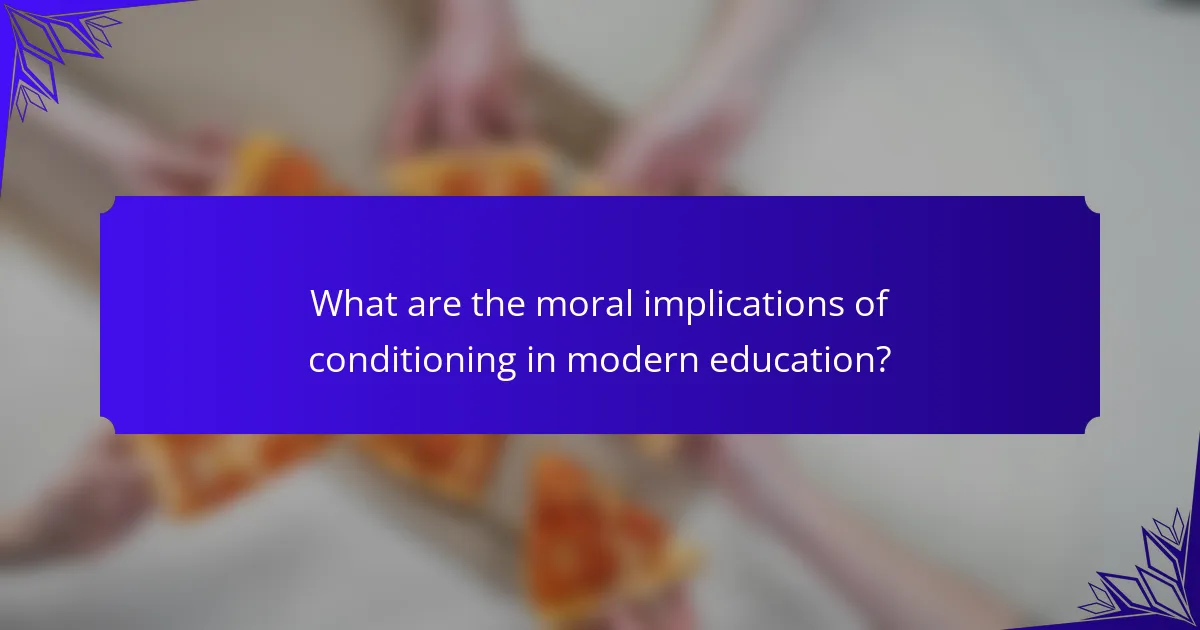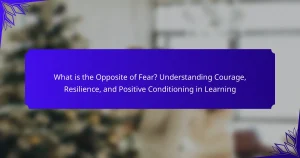Moral questions in learning highlight the ethical challenges educators face in conditioning students. This article explores the implications of autonomy and manipulation, the role of technology in education, and the balance between effective teaching and ethical considerations. It also addresses best practices for fostering critical thinking and open discussions in diverse classrooms. Understanding these aspects is vital for promoting responsible educational environments.

What are the moral implications of conditioning in modern education?
Conditioning in modern education raises significant moral implications, particularly regarding autonomy and manipulation. Ethical concerns arise when students are conditioned to conform to specific behaviors or beliefs without critical thinking. For example, techniques like positive reinforcement may enhance learning but can also lead to dependency on external validation.
The balance between effective teaching methods and ethical considerations is crucial. Educators must ensure that conditioning practices promote genuine understanding rather than mere compliance. This challenge is amplified in diverse classrooms, where individual needs and backgrounds vary widely.
Ultimately, the moral implications of conditioning in education necessitate a careful examination of methods used and their long-term effects on students’ critical thinking and independence. Addressing these concerns can lead to more ethically sound educational practices that respect student agency.
How do ethical frameworks shape learning practices?
Ethical frameworks significantly influence learning practices by guiding moral decision-making. They shape educational environments, curriculum design, and teacher-student interactions. For example, frameworks like utilitarianism prioritize outcomes that maximize overall benefit, while deontological ethics emphasize adherence to rules and duties. These approaches affect how educators address issues such as equity, inclusivity, and respect for diverse perspectives. As a result, ethical considerations lead to more holistic and responsible learning experiences, fostering critical thinking and moral reasoning among students.
What role does student autonomy play in conditioning?
Student autonomy significantly enhances conditioning by fostering intrinsic motivation and engagement. When students have control over their learning processes, they are more likely to embrace challenges and persist through difficulties. This autonomy encourages critical thinking and ethical decision-making, essential components in modern education. Research indicates that students who exercise autonomy demonstrate improved academic performance and satisfaction, reflecting a unique attribute of effective learning environments. Empowering students in their learning journey not only conditions them for success but also cultivates a sense of responsibility and self-efficacy.
What are the various forms of student autonomy?
Student autonomy manifests in various forms, including decision-making, self-directed learning, and goal-setting. Decision-making allows students to choose their learning paths. Self-directed learning encourages students to take charge of their educational journey. Goal-setting enables students to define and pursue personal academic objectives. Each form enhances engagement and fosters critical thinking skills.
How can autonomy enhance learning outcomes?
Autonomy enhances learning outcomes by fostering motivation, critical thinking, and personal responsibility. When learners have control over their educational choices, they are more engaged and invested in their learning process. This engagement often leads to improved retention of information and deeper understanding of complex concepts. Research indicates that autonomy supports self-directed learning, which is essential in modern educational challenges. Encouraging autonomy can transform traditional learning paradigms, making education more relevant and effective.
What are the universal ethical concerns in learning conditioning?
The universal ethical concerns in learning conditioning include the potential for manipulation, the impact on autonomy, and the consequences of behavior modification. These issues raise moral questions about consent, the right to choose, and the long-term effects on individuals. Educators must navigate these challenges while promoting positive learning outcomes. Ethical frameworks guide the responsible application of conditioning techniques in educational settings.
How do consent and coercion manifest in educational settings?
Consent and coercion in educational settings often manifest through power dynamics and social pressures. Students may feel compelled to conform to peer expectations or authority figures, impacting their genuine consent. Research indicates that environments fostering open communication enhance consent, while those with rigid hierarchies can lead to coercion. The unique attribute of ethical frameworks in education highlights the need for clear consent processes that respect individual autonomy. As a result, educators must prioritize creating inclusive spaces that empower students to voice their choices without fear of manipulation or undue influence.
What are the implications of behavioral reinforcement?
Behavioral reinforcement has significant implications for learning, ethics, and educational practices. It shapes how individuals respond to stimuli, influencing motivation and behavior. Reinforcement can lead to positive outcomes, such as improved engagement, but it also raises ethical concerns about manipulation and autonomy. The balance between effective conditioning and ethical considerations is crucial in modern education. Continuous assessment of reinforcement strategies ensures alignment with ethical standards while promoting effective learning environments.
How do cultural perspectives influence moral questions in learning?
Cultural perspectives significantly shape moral questions in learning by influencing values, behaviors, and ethical frameworks. Different cultures prioritize various moral principles, affecting how students engage with ethical dilemmas. For example, collectivist cultures may emphasize community welfare, while individualist cultures focus on personal rights. This divergence leads to varied interpretations of moral issues in educational settings. As a result, educators must navigate these cultural differences to foster inclusive learning environments that respect diverse viewpoints. Understanding these influences is essential for addressing modern educational challenges effectively.

What unique challenges arise from technology in education?
Technology in education presents unique challenges such as ethical concerns, data privacy issues, and the impact of digital distractions. These challenges require educators to navigate moral questions regarding student conditioning and the implications of technology on learning. For instance, reliance on technology can lead to diminished critical thinking skills. Additionally, the use of data analytics raises questions about student privacy and consent. Addressing these issues is crucial for fostering a responsible educational environment.
How does AI impact ethical considerations in conditioning?
AI significantly influences ethical considerations in conditioning by introducing biases and altering learner interactions. It raises concerns about data privacy, consent, and the potential for manipulation. For instance, AI systems may inadvertently reinforce stereotypes through biased training data, leading to ethical dilemmas in educational settings. Additionally, the transparency of AI algorithms becomes crucial, as educators must ensure that conditioning practices are fair and equitable. The unique attribute of AI’s adaptability allows it to tailor learning experiences, but this must be balanced with ethical accountability to prevent misuse.
What are the risks of algorithmic bias in educational tools?
Algorithmic bias in educational tools can lead to unfair treatment of students, affecting their learning outcomes. This bias may reinforce stereotypes, limit opportunities, and perpetuate inequality. For example, biased algorithms can misinterpret student performance data, leading to inappropriate recommendations or support. Addressing these risks requires transparency, diverse data sets, and regular audits of the algorithms used in educational settings. As a result, ethical considerations must guide the development and implementation of these tools to ensure equitable access to education.
How can educators ensure ethical AI usage?
Educators can ensure ethical AI usage by establishing clear guidelines and promoting transparency. They should prioritize student privacy and data security while integrating AI tools in the classroom. Training programs on AI ethics can raise awareness among educators and students alike. Collaborative discussions about ethical dilemmas in AI foster critical thinking and moral reasoning. Regular assessments of AI tools’ impact on learning outcomes are essential for continuous improvement.
What is the role of data privacy in learning environments?
Data privacy plays a crucial role in learning environments by safeguarding personal information and fostering trust. Protecting student data ensures compliance with regulations, enhances ethical standards, and promotes a secure educational experience. As educational institutions increasingly rely on technology, the need for robust data privacy measures becomes vital to prevent misuse and maintain confidentiality. Implementing effective data privacy practices not only protects individuals but also supports the integrity of the learning process.

What rare ethical dilemmas are faced in modern educational conditioning?
Modern educational conditioning faces rare ethical dilemmas such as the manipulation of student autonomy, the balance between standardized testing and individual learning styles, and the implications of data privacy in personalized learning. These dilemmas challenge educators to navigate moral questions while ensuring effective teaching methods. For instance, conditioning techniques may prioritize compliance over critical thinking, raising concerns about the long-term impact on student development. Additionally, the use of technology in education often leads to ethical questions regarding consent and the ownership of student data, complicating the landscape of modern learning environments.
How do high-stakes testing environments challenge ethical standards?
High-stakes testing environments often compromise ethical standards by prioritizing scores over learning. This leads to increased stress, teaching to the test, and potential dishonesty among students. The pressure to perform can undermine the integrity of educational assessments, creating a culture where success is measured solely by test results rather than holistic development. As a result, educators face moral dilemmas regarding fairness and the true purpose of education.
What are the consequences of behavioral manipulation in educational settings?
Behavioral manipulation in educational settings can lead to ethical dilemmas, reduced autonomy, and long-term psychological effects. These consequences challenge the integrity of learning environments. For example, students may experience decreased motivation if they feel coerced into certain behaviors. Additionally, manipulation can foster distrust between educators and students, undermining the educational relationship. Ultimately, these effects can diminish the overall quality of education and hinder personal development.

What best practices can educators adopt to navigate moral questions in learning?
Educators can adopt best practices such as fostering open discussions, integrating ethical frameworks, and encouraging critical thinking to navigate moral questions in learning. These strategies promote a safe environment for exploring complex issues.
Promoting open discussions allows students to voice diverse perspectives. This engagement cultivates empathy and understanding among peers. Integrating ethical frameworks helps students apply moral reasoning to real-world scenarios. Encouraging critical thinking equips learners to analyze situations from multiple angles, enhancing their decision-making skills.
Additionally, incorporating case studies relevant to students’ lives can contextualize moral dilemmas. This approach bridges theory and practice, making ethical considerations more relatable.
Lastly, continuous professional development for educators on moral education ensures they remain equipped to guide students through these challenges effectively.
How can educators balance conditioning with ethical teaching?
Educators can balance conditioning with ethical teaching by integrating ethical considerations into their conditioning practices. This involves fostering critical thinking and promoting autonomy among students. Ethical teaching emphasizes respect for individual values and encourages dialogue, allowing students to understand the implications of conditioning. Additionally, educators should reflect on their own biases and the impact of conditioning on diverse learners. By prioritizing ethical frameworks, educators can create a learning environment that supports both effective conditioning and moral development.
What strategies can enhance ethical decision-making in educational contexts?
To enhance ethical decision-making in educational contexts, implement strategies that promote critical thinking and moral reasoning. Encourage open discussions about ethical dilemmas, integrating real-world scenarios into the curriculum. Foster a culture of reflection where students assess the consequences of their choices. Provide training for educators on ethical frameworks, ensuring they model ethical behavior. Lastly, create collaborative projects that emphasize teamwork and shared values, reinforcing the importance of ethics in decision-making.
What common mistakes should educators avoid regarding ethics in conditioning?
Educators should avoid underestimating the importance of ethical frameworks in conditioning. Common mistakes include neglecting informed consent, failing to consider the long-term impacts of conditioning, and not addressing biases in instructional methods. Additionally, overlooking the diverse needs of learners can lead to ethical dilemmas. These errors can undermine the integrity of educational practices and harm student development.


